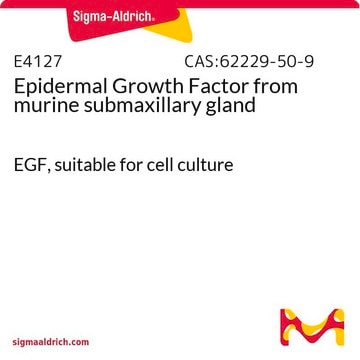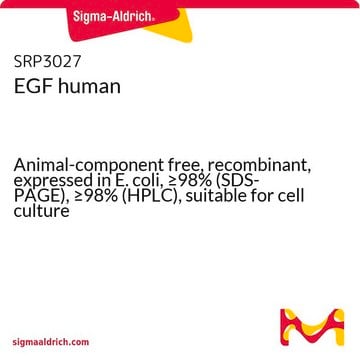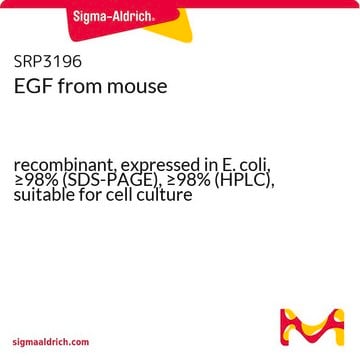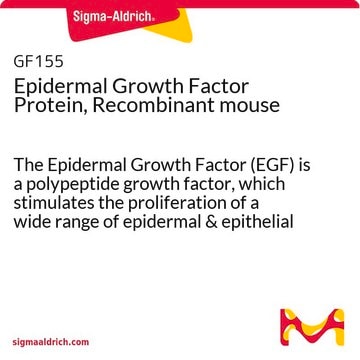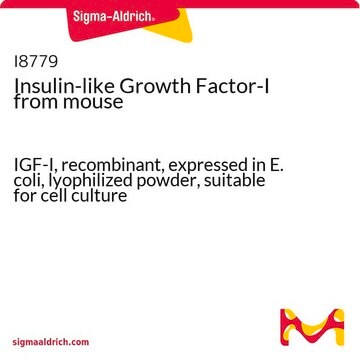E5160
Epidermal Growth Factor from mouse
EGF
Synonim(y):
Mouse EGF, Mouse Epidermal Growth Factor
About This Item
Polecane produkty
pochodzenie biologiczne
mouse
Poziom jakości
rekombinowane
expressed in E. coli
Próba
≥90% (SDS-PAGE)
Postać
lyophilized powder
siła działania
0.05-1 ng/mL ED50/EC50
masa cząsteczkowa
~6 kDa
opakowanie
pkg of 100 μg
warunki przechowywania
avoid repeated freeze/thaw cycles
metody
cell culture | mammalian: suitable
zanieczyszczenia
≤1 EU/μg endotoxin (Protein)
kolor
white
rozpuszczalność
water: soluble 0.10 mL, clear, colorless
numer dostępu UniProt
temp. przechowywania
−20°C
informacje o genach
mouse ... Egf(13645)
Opis ogólny
Zastosowanie
Działania biochem./fizjol.
Postać fizyczna
Cytowanie
2. Jorissen, R.N., et al., Epidermal growth factor: mechanisms of activation and signaling. Exp. Cell Res., 284, 31-53 (2003).
3. Herbst, R.S., Review of epidermal growth factor receptor biology. Int.J. Radiat. Oncol. Biol., Phys., 59, S21-S26 (2004).
4. Mehta, V.B., and Besner, G.E., HB-EGF promotes angiogenesis in endothelial cells via PI3-kinase and MAPK signaling pathways. Growth Factors, 25, 253-263 (2007).
5. Bower, J.M., et al., The inhibition of gastric acid secretion by epidermal growth factor. Experientia, 31, 825-826 (1975).
6. Schonbrunn, A., et.al., Epidermal growth factor and thyrotropin-releasing hormone act similarly on a clonal pituitary cell strain. Modulation of hormone production and inhibition of cell proliferation. J. Cell Biol., 85, 786-797 (1980).
7. Mimura, Y., et al., Epidermal growth factor induces fibronectin expression in human dermal fibroblasts via protein kinase C delta signaling pathway. J. Invest. Dermatol., 122, 1390-1398 (2004).
8. Warner, M.R. et al., Ametantrone inhibits prostaglandin-mediated resorption in bone organ culture. Prostaglandins, 28, 469-476 (1984).
9. Grotendorst, G.R., et al., EGF and TGF-alpha are potent chemoattractants for endothelial cells and EGF-like peptides are present at sites of tissue regeneration. J. Cell. Physiol., 139, 617623 (1989).
10. Schultz, G., et al., EGF and TGF-alpha in wound healing and repair. J. Cell. Biochem., 45, 346-352 (1991).
11. George-Nascimento, C., et al., Characterization of recombinant human epidermal growth factor produced in yeast. Biochemistry, 27, 797-802 (1988).
Kod klasy składowania
11 - Combustible Solids
Klasa zagrożenia wodnego (WGK)
WGK 1
Certyfikaty analizy (CoA)
Poszukaj Certyfikaty analizy (CoA), wpisując numer partii/serii produktów. Numery serii i partii można znaleźć na etykiecie produktu po słowach „seria” lub „partia”.
Masz już ten produkt?
Dokumenty związane z niedawno zakupionymi produktami zostały zamieszczone w Bibliotece dokumentów.
Klienci oglądali również te produkty
Nasz zespół naukowców ma doświadczenie we wszystkich obszarach badań, w tym w naukach przyrodniczych, materiałoznawstwie, syntezie chemicznej, chromatografii, analityce i wielu innych dziedzinach.
Skontaktuj się z zespołem ds. pomocy technicznej